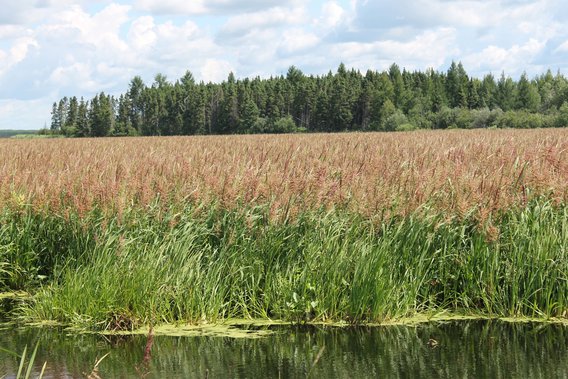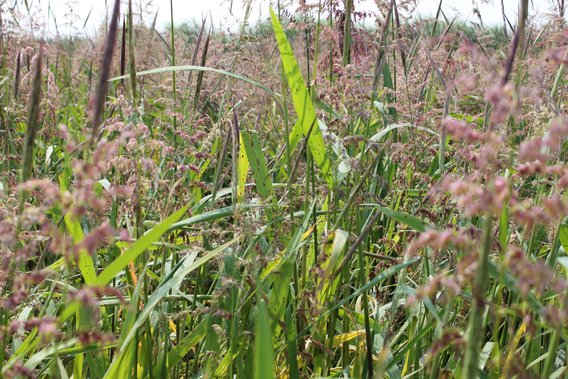By Claudia Castell-Miller

Wild rice, the state grain of Minnesota, is an iconic staple food well-known for its unique flavor and nutrient profiles. University of Minnesota Kimball/Samac Labs Researcher Claudia Castell-Miller joins us today to share knowledge and experiences from her collaborative research into wild rice pathogens, genetics, and disease management practices:
Wild rice in Minnesota
Wild Rice (Zizania palustris L.) is an aquatic grass that is endemic to North America (Minnesota, Wisconsin and central-south Canada). The species has been given several common names including Manoomin (“good berry/seed”), and “folle avoine” (fool’s or wild oats). It naturally grows in peat and clay-soils of shallow, slow moving waters of rivers and lakes.
In the 1950s, a group of entrepreneurs started wild rice cultivation in man-made paddies in the northern areas of Minnesota. Nowadays, there are three main areas of cultivation in Minnesota: Clearbrook/Gonvick, Kalliher/Waskish, and Aitkin/Deer River. These produce around 15 million pounds of finished grain annually on about 11,000 acres, making Minnesota the top cultivated wild rice grain producer.
Wild rice seeds remain dormant for a period of 3 to 4 months (in water-saturated soil) before germination. Planting is done in fall or spring, and soon after, the paddies are flooded. Seeds start germination at soil temperatures of around 40 ºF, usually in early May, after which the seedlings produce three submerged leaves, and later a floating leaf stage consisting of one or two leaves at the end of that month. In June, aerial leaves and tillers are produced. The number of tillers depends on plant density and water depth. From July to August, stem elongation, booting and flowering occur. Wild rice is a monoecious species, where female flowers located in the upper portion of the panicle are receptive before the male flowers start shedding pollen. This difference in maturity forces cross pollination between different plants, resulting in very heterozygous and heterogeneous wild rice populations. Harvest is done by modern combines at 36 to 40% grain moisture in early- to mid-September. The plant cycle is about 110 to 130 days with variation due to weather (e.g., temperature), cultivars and fungicide application.
Overall, wild rice is important in Minnesota food traditions in the Native- (Ojibway, Siouan, non-Ojibway Algonquian, among others) and European-American communities. This is due to its spiritual meaning in Native settings, peculiar flavor, versatile uses in recipes, and its nutritional components. Wild rice is high in protein, minerals and vitamins, in addition to providing carbohydrates and fiber.
Claudia meets wild rice pathology
I learnt about wild rice and its pathogens in an introductory Plant Pathology course in our Department with Dr. James Percich, and from invited lecturers such as Dr. Robert Nyvall and Peter Imle (wild rice grower and producer). During my USDA-ARS post-doctoral work in the Samac lab we studied the genetic diversity of Bipolaris oryzae populations from the three main cultivation areas in Minnesota, and the genome assembly and gene annotations of the isolate TG12Lb2 (collected in Aitkin, MN), which provided information about pathogenicity factors of this organism. In 2015, there was a disease outbreak on cultivated wild rice in all the cultivation areas. Dr. Samac and I started working with the Minnesota Cultivated Wild Rice Council and the growers to understand what pathogen(s) was/were causing the outbreak and how we could stop it. It was very rewarding research since we worked on farms with growers, aerial fungicide applicators, and other workers linked to the industry to stop the epidemic. Equally relevant is that the teamwork paid off when we found that B. oryzae was the prevalent pathogen isolated from leaf and stem samples, and that the right application timing and doses of fungicides stopped the disease outbreak, and reduced the amount of inoculum in the field. In 2019, we started collaborating with Dr. Jennifer Kimball, the cultivated wild rice breeder at the University of Minnesota (UMN), and together we are focusing on enhancing genetic disease resistance in the cultivated wild rice germplasm.

Wild rice health and fungal pathogens
We use applied (field, greenhouse and molecular) plant pathology research to understand the makeup of the disease triangle components to keep improving the integrated disease management system (IDM) practices used by growers and thus, mitigate yield losses due to fungal pathogens. The IDM system, which has been evolving since the 1970s, is mostly based on sanitation of infected residue, cultivars with improved genetic resistance, fertilization, rotations with non-host crops, and fungicide applications. We work with growers to establish small and large fungicide testing plots to evaluate their potency in controlling diseases and impact on grain production. This is paralleled with risk assessments of fungicide resistance/tolerance of fungal populations to the current active ingredients. We also conduct seasonal plant disease scouting, pathogen identification, and population dynamics monitoring in paddies. A two-year study with fungicide and non-fungicide control treatments, with monitoring of environmental variables and with global microorganism identification, provided interesting information about seasonal disease progress, effect of weather, and associated pathogens. We are also doing selection for disease resistance and susceptibility in the field and in greenhouse settings, and investigating plant disease resistance and pathogen virulence at the molecular level.
Currently, the most damaging pathogens are fungi, mainly belonging to the genus Bipolaris. In paddies, high relative humidity surrounding the plants, low to moderate genetic resistance in the wild rice germplasm, and the presence of virulent fungi contribute to disease development. The ascomycete, necrotroph fungus Bipolaris oryzae has been the most devastating, inflicting severe grain yield losses if left uncontrolled (e.g., without fungicides applications). It causes fungal brown spot and it can infect most aerial parts of the plant except caryopsides. The fungus is polycyclic if humidity is high (70% to 100%) and warm temperatures (28°C to 30ºC) persist during the growing season. It overwinters in infected plant residue that likely becomes the source of primary inoculum in the following season. B. oryzae isolates from Minnesota are genetically diverse, and the fungal genome is rich in genes for pathogenicity and virulence. Other Bipolaris spp. are present such as the ascomycete, hemibiotroph B. sorokiniana, causing spot blotch, and B. gigantea, the zonate eyespot agent.
Other fungal pathogens are the basidiomycete Ceratorhiza hydrophila and the ascomycete Magnaporthe salvinii, both causing leaf sheath and stem rot; the ascomycete Phaeosphaeria oryzae causing leaf blotch; Colletotrichum sublineola causing anthracnose; and a complex of Fusarium species causing Fusarium head blight. Other fungi, bacteria and viruses are found or have been described, but nowadays they do not cause serious grain losses.
Recently, we uncovered additional Bipolaris spp. and other pathogens through annual surveys and a metagenomics study that we are starting to evaluate for their potential impact on wild rice grain production.
Learning from wild rice’s transcriptome
We designed an RNA sequencing study to enhance our understanding of the global gene expression between the wild rice cultivar Itasca - C12 and B. oryzae at 24 hours and 48 hours of their interaction. Itasca - C12 activated numerous plant recognition receptors after pathogen infection, followed by active transcriptional reprogramming of signaling mechanisms driven by Ca2+ and its sensors, mitogen-activated protein kinase cascades, activation of an oxidative burst, as well as phytohormone signaling mechanisms. Several transcription factors associated with plant defense were found to be expressed. Evidence of diterpenoid phytoalexins biosynthesis, among expression of other defense genes (pathogenesis related proteins, disease resistance genes) were found. In B. oryzae, predicted genes associated with pathogenicity including secreted effectors that could target plant defense mechanisms were expressed. Those include a putative isocitrate lyase, a secreted isochorismatase effector, a non-ribosomal peptide synthetases, and several putative fungal peptidases. Additional differentially expressed genes associated with pathogenicity and virulence included carbohydrate active enzymes, monooxygenases, regulatory proteins, an MFS antiporter protein, and toxins/mycotoxins, among others. These findings will help to direct future research in wild rice defenses and fungal pathogenicity.
Solutions and next steps
The most effective way to manage wild rice diseases is the complete implementation of the IDM practices. Within its components, the strobilurin- and/or azole-based fungicides applied at the appropriate time and following the manufacturer’s recommendations are among the most profitable and efficient strategies in reducing diseases in wild rice production systems. This is coupled with risk assessment for selection to fungicide resistance/tolerance of the main pathogens.
The next steps in wild rice pathology research are very interesting and challenging. We have started selections for genetic disease resistance in wild rice populations. We are focusing on understanding specific disease phenotypes of yield-limiting pathogens by developing standard analytic scales, and we envision potential use of drones to capture images of diseased phenotypes. We are trying to optimize protocols for standard field inoculation to increase the capability for germplasm evaluation. In addition, we will continue genotyping wild rice populations and understanding specific genes putatively associated with disease resistance and susceptibility. These efforts will require collaboration with researchers in diverse disciplines and institutions.
Collaborating to make progress
Everyone involved in wild rice research is relevant to accomplish our goal of reducing the impact of diseases in wild rice grain production. The Minnesota Cultivated Wild Rice Council has been key in coordinating work and acquiring funds for our research, as well as the Minnesota wild rice growers, and associated industries and Co-ops. Most of our funds come from the Minnesota Department of Agriculture through the AGRI-program. In the past ARS-USDA provided resources as well.
My collaborators are mostly from the UMN and USDA-ARS, and include Dr. Jennifer Kimball, who is the leader of wild rice breeding research program (Department of Agronomy and Plant Genetics), Dr. Deborah Samac (research leader of the USDA-ARS Plant Science Research Unit [PSRU] and an adjunct professor in the Plant Pathology Department), Dr. Thomas Kono (Informatics Analyst, Minnesota Supercomputing Institute), Dr. Daniel Schlatter (Research Microbiologist, USDA- ARS PSRU and Adjunct Assistant Professor in the Plant Pathology Department), Dr. Ashish Ranjan (Molecular Plant Pathologist, Assistant Professor in the Plant Pathology Department), and Dr. Zhanyou Xu (Research Geneticist, USDA- ARS PSRU).
Photos courtesy Claudia Castell-Miller
Selected literature
Oelke, E. A. (2007). Saga of the grain: a tribute to Minnesota cultivated wild rice growers. Minnesota Cultivated Wild Rice Council. Lakeville: Hobar Publications.
Duquette, J., and Kimball, J. A. (2020). Phenological stages of cultivated northern wild rice according to the BBCH scale. Annals of Applied Biology. 176, 350–356. https://doi.org/10.1111/aab.12588
Johnson, D. R. and Percich, J. A. (1992). Wild rice domestication, fungal brown spot disease, and the future of commercial production in Minnesota. Plant Disease. 76, 1193–1198. https://doi.org/10.1094/PD-76-1193
Castell-Miller, C. V., Schlatter, D., and Samac, D. A. (2021). Efficiency and profitability of fungicides in controlling Bipolaris diseases and enhancing grain yield in cultivated wild rice (Zizania palustris). Crop Protection. 141, 105455–. https://doi.org/10.1016/j.cropro.2020.105455
Castell-Miller, C. V., Gutierrez-Gonzalez, J. J., Tu, Z. J., Bushley, K. E., Hainaut, M., Henrissat, B., et al. (2016). Genome assembly of the fungus Cochliobolus miyabeanus, and transcriptome analysis during early stages of infection on American wildrice (Zizania palustris L.). PloS One. 11, e0154122–e0154122. https://doi.org/10.1371/journal.pone.0154122
Samac D.A. and Castell-Miller C.V. (2023). “Diseases of wild rice (Zizania palustris)” in Diseases of Field Crops, eds. Hollier, C., Boyd Padgett, G. and Draper M.A. pp: 373-381. APS Press, St. Paul, MN.
